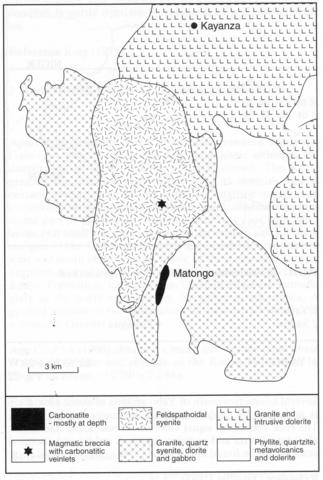stripes
The Upper Ruvubu complex is emplaced into phyllites, metaquartzites and metavolcanics, cut by granites, of the Precambrian Burundian formation. The complex consists of two major units: the first comprises principally a range of basic non-alkaline rocks, the second, and younger, a range of silica undersaturated alkaline rocks. The earlier unit rocks include olivine gabbros and diorites, monzonites, quartz syenites and granites. The second unit is an oval area of 15x7 km associated with numerous dykes. The principal rocks are syenites but some are described as monzonites, and they are characterized by their extreme textural heterogeneity including aplitic, coarse- and medium-grained, pegmatitic, porphyritic, brecciated and banded, including varieties interpreted as magmatic layering (Tack and De Paepe, 1981). The syenites and monzonites contain nepheline, sodalite and cancrinite. Lubala et al. (1985) divide these rocks into (a) feldspathoid syenites with arfvedsonite and aegirine, (b) feldspathoidal syenites with iron-rich biotite and (c) quartz syenites with ferrohastingsite and lepidomelane. Some carbonatite veinlets occur in intrusive breccia within the syenites. Analyses of five feldspathoidal syenites are given by Tack and De Paepe (1981). Carbonatite is present outside, but near, the southeastern margin of the complex, this occurrence being known as Matongo-Bandaga. The carbonatite is concealed by a weathered cover up to 35m thick, but drilling indicates that it extends over an area of 2.5x0.5 km aligned northeast-southwest. The carbonatites are invariably vertically to sub-vertically banded and appear to be principally sovites with aegirine, analyses of which averaged 1.93% V2O5 and O.45% Cr2O3, apatite, biotite, which is very abundant in some rocks, fibrous green amphibole, cancrinite and accessories including pyrochlore high in Ta and U, molybdenite, crandallite, monazite, pyrite, magnetite and pyrrhotite. One borehole encountered syenites containing sodalite and cancrinite and rocks interpreted as fenites (Mariano, 1983).
CAHEN, L., SNELLING, N.J., DELHAL, J., and VAIL, J.R. 1984. The geochronology and evolution of Africa. Clarendon Press, Oxford. 512 pp.KURTANJEK, M.P. and TANDY, B.C. 1989. The igneous phosphate deposits of Matongo-Bandaga, Burndi. In A.J.G. Notholt, R.P. Sheldon and D.F. Davidson (eds), Phosphate deposits of the world. 2. Phosphate rock resources. 262-6. Cambridge University Press, Cambridge.LUBALA, R.T., KAMPUNZU, A.B. and MAKUTU, M.N. 1985. Un inventaire des complexes anorogeniques du Burundi, du Rwanda et du Zaire. Journal of African Earth Sciences, 3: 169-74.TACK, L. and DE PAEPE, P. 1981. Le massif intrusif de syenites foidales de la Haute-Ruvubu, Burundi. Rapport Annuel pour l’année 1980 du Départment de Géologie et de Minéralogie du Musée Royal de l'Afrique Centrale, Tervuren, Belgique, 173-8.TACK, L. and DE PAEPE, P. 1983. Le volcanisme du Sud-Kivu dans le nord de la plaine de la Rusizi au Burundi et ses relations avec les formations géologiques avoisinantes. Rapport Annuel du Département de Géologie et de Minéralogie du Musée Royal de l’Afrique Central Annees 1981 et 1982, Tervuren, Belgique, 137-45.TACK, L., DE PAEPE, P., DEUTSCH, S. and LIEGEOIS, J.-P. 1984. The alkaline plutonic complex of the upper Ruvubu (Burundi): geology, age, isotopic geochemistry and implications for the regional geology of the Western Rift. In: J.Klerkx and J. Michot (eds) Geologie Africaine - African geology. 91-114. Musee Royal de l’Afrique Centrale, Tervuren.VAN DEN HAUTE, P., JONCKHEERE, R. and MOMBERS, K. 1985. Fission-track dating and thermal history of the alkaline plutonic complex of the Upper Ruvubu (Burundi). 13th Colloquium of African Geology (St.Andrews). Occasional Publication, International Center for Training and Exchanges in the Geosciences. 147.

